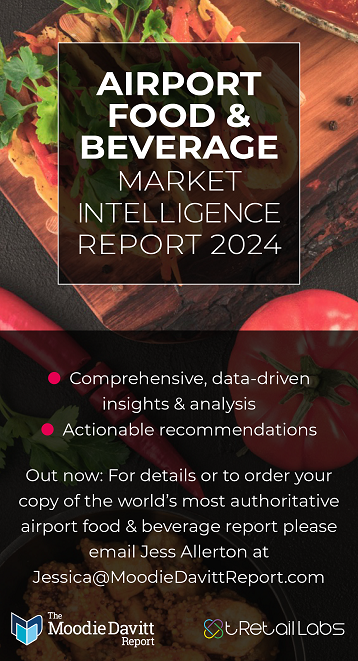
Ude Desh ka Aam Naagrik (Hindi for‘Let the common citizens of the country fly’)
INDIA. In the latest of a series of articles about travel retail and aviation in India, long-time travel retail and aviation expert Shriram Sanjeevi assesses food & beverage opportunities across the nation’s smaller airports.

Over the past three months, I had the opportunity to travel extensively across India, especially to the smaller cities where the consumption story is on the rise.
My employer, Indian Terrain [India’s leading brand for men’s and boy’s clothing -Ed], runs over 210 stores across the country and over a third of them are in Tier 2/3 towns – i.e. those with a domiciled population of less than 1.5 million (15 lakhs).
A decade back, such travel to smaller towns would have been tumultuous, with one having to change trains and/or buses to reach them. Today, it’s much simpler with the presence of smaller airports and even smaller aircraft – mostly ATR or the equivalent.
India has 125+ operational airports – a +100% growth in less than ten years, driven by the push on commercial aviation by the Union Government which has been in charge since 2014. The top six metro cities – Mumbai & Delhi (which collectively command a market share of well over 50%), Chennai, Bangalore, Hyderabad and Kolkata – generate 80% of total air traffic. The rest of the passenger volume comes from over 100 airports, with many having just four to six flights per day.
Most of the flights to and from them (ones I have travelled on and others) have a load factor of over 90%. The Tier 2/3 airports get mid-day rather than early morning or late evening slots. But that fuels travel retail even further.
To my surprise, I saw a Starbucks café at airports in Pune, Jodhpur, Bhubaneswar and many such smaller airports. During my stint at Café Coffee Day a decade back, we would aspire to have cafés in larger airports. But this aggressive expansion by a global brand reinforces my confidence in the burgeoning opportunity of selling products and experiences at smaller airports.

In another instance, our early evening flight was delayed and there was a long queue to acquire some food at the airport counters.
Airport privatisation began in India in 2004 with two new brownfield airports at Delhi and Mumbai, followed by two new greenfield airports at Bangalore and Hyderabad. When I was setting up Bangalore’s first-ever modern and organised travel retail business at Bangalore in 2006, little did I realise that the smaller airports would provide such a large opportunity for retailers, brands and F&B alike.
UDAN (meaning flight in Hindi) – an acronymn for Ude Desh ka Aam Naagrik (‘Let the common citizens of the country fly’), the pet-project of the Modi government to empower smaller towns with an operational airport – hit its peak in September 2018 with the inauguration of Pakyong Airport near Gangtok in the Northeastern state of Sikkim, a traveller’s paradise. Previously, Sikkim had been India’s sole state with no functional airport.

While air travel came to a screeching halt in March 2020 due to the COVID-19 pandemic, from February 2022 onwards, Indians have been travelling with a vengeance – ‘revenge travel’ as it is dubbed. Small airports are benefiting along with their giant counterparts and the F&B opportunity growing accordingly.

What was surprising for me is how comfortable many passengers are to spend at smaller airports on F&B, be it at a branded outlet such as Starbucks or an unbranded one. While the dwell times are relatively shorter now – flights depart and land on time (surprisingly!) – and the security checks are tiring, I could see many passengers comfortably seated at their respective gates before boarding.
Since these are very small departure areas, the outlets are quite accessible even if they are an afterthought in terms of airport construction. Taking food, coffee and other beverages onto the flight is quite common too, so the F&B operators ensure adequate packing to avoid spillage. While inflight sales are picking up pace, the options are much more expensive and choices are limited, so passengers seem to prefer buying such items at the airport counters before flying.
What is still lacking is pre-booking of food from airport counters. I have written about this opportunity in one of my previous articles, having spoken to some of the reputed F&B operators at airports as well as to airport companies. This is a huge miss, especially given the propensity to spend on discretionary purchases is on the rise in India, judging by the burgeoning retail consumption in H1 FY 2223.
Really, it is not such a difficulty to tie up with local F&B partners and get the food boarded inside the aircraft during the 40-minute layover between two flight movements.
This way, the airline would get a small commission from the airport operators while the F&B partner would also increase sales by utilising its capacities better. For a small airport with 6 to 12 flight movements per day, this is not impossible. And passengers such as me would be spared from staring at the dreaded inflight tomato-cheese laden sandwiches, the small boxes of almonds or even smaller packs of chips which are disposed of faster than the speed of an aircraft at 30,000 feet.











